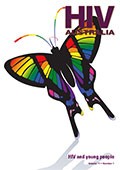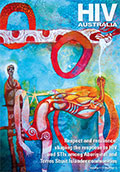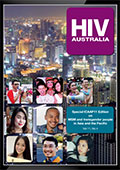HIV AUSTRALIA 2013
HIV Australia 2013
Summary of articles published in 2013.

HIV AUSTRALIA Vol. 11 No. 1
HIV and young people
This edition of HIV Australia examines HIV and other sexually transmissible infections (STIs) among young people in Australia.
Authors discuss latest statistics, research, and health promotion initiatives focusing on people under 30, emphasising the importance of peer-lead approaches and communication strategies that directly involve young people speaking for themselves about HIV and sexual health.
Book review: How AIDS ends: an anthology from San Francisco AIDS Foundation
ABIGAIL GROVES critiques a collection of essays looking towards an ‘AIDS free generation’.
Regional feature: ‘Self-issues’: HIV and the psychosocial side of sexual risk-taking
ATTAPON ED NGOSKIN explores links between HIV, self-esteem and risk taking among young men who have sex with men and transgender people in Asia and the Pacific.
Love Sex? Love Condoms! The NSW Festivals Initiative
BROOKE SHEPHERD profiles a sexual health outreach program that is taking sexual health messages out on the road.
Sexual health and HIV health promotion among young culturally and linguistically diverse people in Western Sydney
ANDREW C STONE and ELIZABETH MLAMBO outline a framework of engagement to support the sexual health of young people from culturally diverse backgrounds.
Sex education needs to begin earlier
JENNY WALSH asks what is the right age for children to begin learning about sex?
Sexuality education in Australian Secondary Schools: averting a sexual health crisis among young people
JAMES MAY reports on the current state of sex education in Australian schools and says it’s time for change.
When HIV-positive children grow up: A critical review of the ‘transition’ literature
CHRISTY NEWMAN and ASHA PERSSON critique some common assumptions made in international literature about HIV-positive adolescents transitioning to adult care and discuss upcoming Australian qualitative research into the issues.
Paediatric HIV in Australia: 30 years of a changing landscape
ANGELA MILLER, JOHN ZIEGLER and PAMELA PALASANTHIRAN chart the history of HIV among children in Australia.
Positive status: Jason’s coming out story
FINN O’KEEFE hears a good news story about coming out as HIV-positive on Facebook.
Where they hang out: creating a peer-led social media campaign to promote HIV testing in young gay men
WILLS LOGUE traces the development of a multimedia health promotion campaign developed by and for young same-sex attracted me.
Off the map? The feasibility of HIV prevention workshops for young gay and bisexual men in rural and regional Australia
ALDO SPINA examines whether the extension of existing peer-education models into regional and rural areas is the most effective approach.
Young gay men: capable, resilient and resourceful
JAMES GRAY, THOMAS MUNRO and MICHAEL YATES discuss peer-driven health promotion approaches to address HIV among young gay men.
Sexually transmissible infections among young people in Australia: an overview
In this article, the Kirby Institute provides a snapshot of the latest surveillance data on sexually transmissible infections (STIs) and HIV among young people in Australia.
Prevention as hyperbole; culture as concupiscence
This is the first in a series of articles drawn from presentations given at the 2012 Australasian HIV/AIDS Conference. Contributors discuss responses to HIV in the combination prevention era and themes connected with working to achieve targets set out in the United Nations 2011 Political Declaration on HIV/AIDS (UNPD).
Vale Professor Anthony Smith
Reflections about Anthony Smith (only available on the AFAO blog)

HIV AUSTRALIA Vol. 11 No. 2
Managing co-existing health conditions
This edition of HIV Australia examines health conditions that can sometimes occur alongside HIV. Articles discuss prevention and treatment, emerging research, and outline ways that HIV-positive people can minimise risk factors and proactively manage co-existing health conditions.
Book review: HIV prevention and bisexual realities
Abigail Groves investigates the erasure of bisexuals in HIV prevention and health promotion.
Regional feature: Kapul Champions: a proud new voice in Papua New Guinea
‘MSM [men who have sex with men] and TG [transgender people] are better positioned than anyone else to say what their HIV-related needs might be…’
Chronic kidney disease in people with HIV: a review of recent developments in Australia
David Gracey discusses why monitoring kidney health is important for HIV-positive people.
Neurocognition and HIV
Rebekah Puls provides an overview of research into the impact of various antiretroviral regimes on cognitive function for people with HIV.
Gay men and anal cancer
Mary Poynten and Andrew Grulich explore the connection between the human papillomavirus (HPV) and anal cancer among gay men, highlighting findings from the SPANC study.
Cardiovascular disease, smoking and HIV: findings from the HealthMap qualitative study
Report by Karalyn McDonald and Julian Elliott for the HealthMap Project Team on findings from the HealthMap qualitative study of Cardiovascular disease, smoking and HIV
Testing for hepatitis C as a sexually transmissible infection: understanding health practitioners’ knowledge and attitudes
SOENKE TREMPER and GUY HUSSEY outline survey results that give insight into GPs’ perspectives on hepatitis C transmission among HIV-positive men who have sex with men.
HIV and hepatitis C co-infection: can we avert another epidemic in Australia by acting fast
In this opinion piece, DAVID PIEPER provides reflections on the emergence of the sexual transmission of hepatitis C among HIV-positive gay men.
Action on hepatitis C: new drugs, new resources
FINN O’KEEFE profiles developments in hepatitis C treatment and health promotion.
Chronic illness and co-morbidities for African Australians living with HIV
Chris Lemoh looks at health challenges experienced by African Australians
QLife: Keeping our LGBTI Communities Connected
FINN O’KEEFE reports on the launch of a national mental health counselling service for lesbian, gay, bisexual, transgender and intersex people.
HIV, mental health and stigma: a brief survey of current research
JASON APPLEBY summarises recent research examining the intersection of HIV and mental health.
Ageing with HIV in Victoria: findings from a qualitative study
KARALYN MCDONALD, JULIAN ELLIOTT and LISE SAUGERES report on key study findings exploring the impacts of ageing and chronic disease on people with HIV.
An elephant in the room? Anal cancer and people with HIV
JASON ONG explains that being alert to potential symptoms and having an annual check-up can minimise the risks of anal cancer.
Bone health and HIV
HILA HASKELBERG outlines a range of bone-related health conditions, discussing proactive steps HIV-positive people can take to maintain optimal bone health.
It’s never too early to take control
Because people with HIV are now living longer, the management of other health conditions – including conditions affecting cardiovascular, liver, kidney and bone health – has become an increasing priority.

HIV AUSTRALIA Vol. 11 No. 3
Aboriginal and Torres Strait Islander people are advised that this edition of HIV Australia contains images, voices or names of people who have passed away.
Respect and resilience:
Throughout this edition of HIV Australia we feature a selection of artworks by internationally-renowned artist Arone Meeks.
Aboriginal and Torres Strait Islander people should be aware that this magazine may contain images or names of people who have passed away.
The Australian Federation of AIDS Organisations (AFAO) acknowledges the traditional owners of the lands we operate on across Australia. AFAO pays tribute to Indigenous Elders past and present – particularly to the Elders who have assisted in producing this edition of HIV Australia.
We also pay tribute to community members who have so generously participated in the research described in this magazine.
Obituary – Vale Malcolm Leech (1956-2013)
It is with great sadness that we note the passing of Malcolm Leech at 12:35am on Friday 20 September from cancer at the Sacred Heart Hospice, Darlinghurst, age 57.
Book review: Condoman and Lubelicious
Since the late 80s, the Aboriginal community has worked tirelessly to find effective models of education for use in the community that give clear and concise health promotion messages.
Regional Feature: Nothing about us without us! HIV and Indigenous peoples
Looking from outside the regional bubble of the Australian/New Zealand/Pacific Islands countries and territories, some might think that HIV is not an obvious Indigenous health priority.
Treatment as prevention: what’s required to make this a relevant strategy in Aboriginal and Torres Strait Islander communities
There have been some significant advances in knowledge recently in the HIV field. Of particular significance is the concept that HIV treatment can be used as prevention tool in reducing HIV transmission for individuals, at the community level and even globally.
What is the role of HIV and STI point-of-care tests in remote Aboriginal and Torres Strait Islander communities
Sexually transmissible infection (STI) and HIV point-of-care tests (otherwise known as rapid tests) can be used at patient visits to test for STIs and HIV, rather than sending off a sample to the laboratory and waiting for the results.
Mind The Gap: addressing HIV and STIs among young people in rural and regional areas
In 2009, the Department of Education and Early Childhood Development released a report on the health and wellbeing of young people in Victoria which revealed over half of all sexually transmissible infection (STI) notifications (chlamydia, gonorrhoea, syphilis and HIV) were among young people aged between 15 and 24 years.
Connecting with youth: how arts-based health campaigns are engaging young Aboriginal people in NSW
The Aboriginal Health and Medical Research Council (AH&MRC) would like to acknowledging the input of Aboriginal communities and workers into these campaigns.
Think About the Choices You Make: creating a culturally appropriate sexual health promotion DVD for young Aboriginal people
Over the past decade, rates of sexually transmissible infections (STIs) have increased in Australia.
Stigma and discrimination won’t bring us down!
Scarlet Alliance, Australian Sex Workers Association, is the national peak body representing the interests of sex workers in Australia.
Findings from the Queensland Injecting Drug Survey (QuIDS): comparing hepatitis C risk behaviours among Indigenous and non-Indigenous people who inject drugs
An estimated 10,000 new hepatitis C (HCV) infections occur each year in Australia. It has been estimated that 91% of new HCV infections are acquired through injecting drug use.
HIV risk practices among Indigenous Australian and Anglo-Australian gay and bisexual men
Aboriginal and Torres Strait Islander (‘Indigenous Australian’) gay and other homosexually active men, transgender people and sistergirls are identified as priority populations in the Third Aboriginal and Torres Strait Islander Blood Borne Viruses and Sexually Transmissible Infections Strategy.
The management of people with HIV who place others at risk (POAR): implications for Aboriginal and Torres Strait Islander people
The National Guidelines for the Management of People with HIV Who Place Others at Risk (or ‘POAR’ for short) is a public health instrument that provides national guidance in relation to the management of people with HIV who are deemed to pose a public health risk of transmitting HIV to others.
Live deadly stronger and longer: Ask for a Test
Live deadly stronger and longer: Ask for HIV, hepatitis & STI testsThe Northern Territory AIDS and Hepatitis Council (NTAHC) has developed ‘Ask for a Test’, an Indigenous blood borne virus (BBV) and sexual health poster campaign.
Celebrating strength: the role of resilience in responding to blood borne viruses and sexually transmitted infections among Indigenous communities
‘Tangible strengths, such as young Indigenous people’s commitments to condoms and STI screening should be celebrated and bolstered to enhance their ability to protect themselves against adverse health outcomes and enhance their resilience against STIs.’
Ngalawi Djardi ‘Sit & Yarn’: ACON Health Retreat for Aboriginal and Torres Strait Islander People Living with HIV
Adapted from the 2012 Ngalawi Djardi Health Retreat Evaluation written by Meggan Grose. ACON has been working with Aboriginal and Torres Strait Islander People since its inception in 1985.
PATSIN: the Positive Aboriginal and Torres Strait Islander Network
We are here right across Australia. Let’s support one another by yarning through our journey.’
Us mob: gar’ban’djee’lum network
gar’ban’djee’lum (‘us mob’) is an independent social network for Aboriginal and Torres Strait Islander gay men, lesbians, bisexuals, transgender people, sistergirls and brotherboys (GLBTSB) in and around Brisbane.
Promoting Aboriginal and Torres Strait Islander gay men and sistergirl sexual health in Queensland: The 2 Spirits program
The 2 Spirits program was originally established to provide health education and community development to Aboriginal and Torres Strait Islander communities and to establish networks for Aboriginal and Torres Strait Islander gay men and sistergirls across Queensland.
Our Destiny Haz Arrived: a national HIV prevention and testing campaign for Aboriginal and Torres Strait Islander gay men and sistergirls
Among Aboriginal and Torres Strait Islander people, gay men, sistergirls and transgender people remain at highest risk of acquiring HIV.
The Anwernekenhe journey
The Anwernekenhe National Aboriginal and Torres Strait Islander HIV/AIDS Alliance (ANA) began its journey on 31 October, 1994 at Hamilton Downs just outside of Alice Springs.
Living positively: Neville’s story
Howdy, my name is Neville Fazulla. Some of you will know me as Mona, Mony, Fuzzy or Olivia and my besties call me sis.
STRIVE: making a difference for sexual health in remote Aboriginal communities
There is an urgency in Australia’s response in addressing the high levels of curable sexually transmissible infections (STIs) that have been present in many Aboriginal and Torres Strait Islander communities for as long as records have been kept.
More work is required to reduce sexually transmissible infections in Aboriginal and Torres Strait Islander communities
Australia’s Aboriginal and Torres Strait Islander population continues to be overrepresented in notifications of sexually transmissible infections (STIs) while at the same time maintaining a stable epidemic of HIV.
Findings from the Goanna Study
Aboriginal and Torres Strait Islander young people are a priority population in all national and jurisdictional sexually transmissible infection (STI) and blood borne virus (BBV) strategies, but until recently we have had little information on which to build and evaluate responses. This situation has changed radically in the past two years, with the implementation of the GOANNA study.
HIV Australia Vol 11 No 3 Editorial
It was over 20 years ago when alarm bells were sounded about the devastating impact that HIV/ AIDS could have on our communities. This hasn’t happened, so thank you!

HIV AUSTRALIA Vol. 11 No. 4
ICAAP 11 special edition
This edition brings together some of the key issues and discussions around current and future responses to HIV, health and human rights for men who have sex with men (MSM) and transgender people in our region.
Content in this edition has been developed in collaboration with APCOM (Asia Pacific Coalition on Male Sexual Health).
Spotlight 5: Haus of Khameleon, Fiji
Haus of Khameleon is a youth and transgender led feminist movement working to create a safe space for Transgender people in Fiji.
Spotlight 4: Chengdu Tongle Health Counseling Service Center, China
Founded in 2002, Chengdu Tongle Health Counseling & Service Center (Chengdu Tongle) is a self-governed MSM NGO in Chengdu, China.
Spotlight 3: Action for AIDS, Singapore
Action for AIDS was the first organisation working with gay men and other men who have sex with men (MSM) in the area of sexual health promotion in Singapore.
Spotlight 2: Naz Male Health Alliance, Pakistan
Naz Male Health Alliance (NMHA) is the first and only men who have sex with men (MSM) and transgender community-based organisation in Pakistan.
Spotlight 1: SWING, Thailand
The Service Workers In Group Foundation (SWING) was established in 2004 to promote and protect the health, human rights and dignity of sex workers.
New media and MSM+ outreach and activism
A range of structural, social and cultural barriers to treatment exist which create difficulties for HIV-positive men who have sex with men (MSM+) to access the treatment services they need.
MSM and transgender youth: underestimated needs of psychosocial health support
Specific data on young MSM and transgender women at higher risk of HIV in the region is sparse, but estimates that do exist give cause for concern.
HIV prevention among MSM and transgender people who use drugs in Asia and the Pacific
Drug use among men who have sex with men (MSM) in Asia is an established trend.
Male and trans* sex workers self-organise against stigma, discrimination and HIV in Thailand
Within the Asia-Pacific region, male and trans* sex workers face a disproportionately high level of stigma, violence, discrimination, homophobia and sex work-phobia from the broader society.
Respecting the rights of trans* people within the HIV response
‘Everyone has the right to the highest attainable standard of physical and mental health, without discrimination on the basis of sexual orientation or gender identity. Sexual and reproductive health is a fundamental aspect of this right.’ Principle 17: The Right to the Highest Attainable Standard of Health.
Diverse Pacific voices: MSM and transgender people in the Pacific
The Pacific spans a huge and diverse geographic and cultural landscape. Within this huge region, there is also much diversity in terms of sexual orientation and gender identity.
Hope, struggle and the city: scaling-up HIV services for men who have sex with men and transgender people across Asia’s megacities
In 2009 the United Nations Development Programme (UNDP) reoriented its work to focus on HIV vulnerability in municipal settings.
From punishment to empowerment: sexuality and gender identity laws in Asia and the Pacific
In 2012, the Global Commission on HIV and the Law highlighted the harmful impacts of punitive laws on the health and human rights of men who have sex with men (MSM) and on transgender people.
Epidemiological overview: MSM and transgender women in Asia and the Pacific
In the third decade of HIV in Asia and the Pacific, the epidemiology of HIV continues to change and to challenge our best efforts to respond.
Editorial
Welcome to the Special ICAAP11 Edition of HIV Australia, focusing on men who have sex with men (MSM) and transgender people across Asia and the Pacific. This edition has been prepared to bring together some of the key issues and discussions around current and future responses to HIV, health and human rights for MSM and transgender people in our region.


